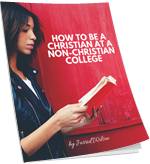If you’re in your first semester you might be confused by the “P” word. If you’re in your last semester it might be all too familiar. Plagiarism is scary—and it should be! It’s stealing and it’s actually pretty common. The easiest way to avoid plagiarism is just that—avoid it. Don’t steal another person’s work. Don’t use papers that aren’t your own. Be a good person. Unfortunately plagiarism is a little more complicated than that. Even people with the best intentions can get caught in its web. Still, it is possible to avoid. Here are 5 ways to avoid the dreaded “P” word:
1. Use the power of the Internet
Back in the day, when cavemen went to college, they had to rely on books. There was even a horrible place called a library that was filled with them! I’m kidding, of course. Still, this is one of those moments to count your blessings. While there are manuals and guides to help you cite your sources properly, there’s also something called Google—and its super helpful. If you’re questioning whether or not something needs to be cited, chances are somebody in the World Wide Web has an answer for you. Give it a try!
2. Ask yourself: Is this my idea?
If the idea you’re presenting isn’t something you came up with on your own, give credit where credit is due. It’s a good rule for life, and for your papers. It’s just common courtesy. On a moral level think about that author and the time they spent perfecting their work. If you spent that time and energy, you’d want the credit too. Maybe one day you’ll write an article or book of your own. It’s the world of academia, and it’s important to play your part. It’s just the standard rule. If it’s not your idea, tell the reader whose idea it is.
3. When in doubt—cite!
Sometimes just the smallest change to a sentence will turn it into plagiarism. I’ll never forget my professor showing us how easy it is to slip up—it was like a scene from a horror film. Her fear tactic worked because I triple-checked every citation in that term paper. I was citation crazy, and in some ways you need to be. College isn’t like high school. While some professors might have grace, most won’t. Plagiarism is a serious offense whether you intended to our not. Best case scenario: they give you a chance to right your wrongs. Worst case scenario: they fail you. The safest choice is sticking with my motto: when in doubt—cite!
4. Use a Plagiarism Checker
Most schools actually have online databases that crosscheck your paper for plagiarism. This checker occurs after you turn it in, but there are similar options you can do on your own. Use a plagiarism checker beforehand. It might catch spots where you failed to use your own words, or forgot to cite properly. Don’t let plagiarism catch you off guard. There are so many ways to prevent it if you just look.
5. Don’t hesitate to ask…
If you feel unsure about whether or not to cite, don’t hesitate to ask. Don’t let an accidental slip-up turn into plagiarism. Your professor is there to guide you—take advantage! They’ll be much more forgiving reading an unfinished draft in office hours than the final paper. Plus, schools typically have writing centers. Go the extra mile and set up a meeting—tutors will be able to help. They know the ins and outs of paper writing; it’s their job. This reflects your work ethic. Show that you care and take time to ask questions.






